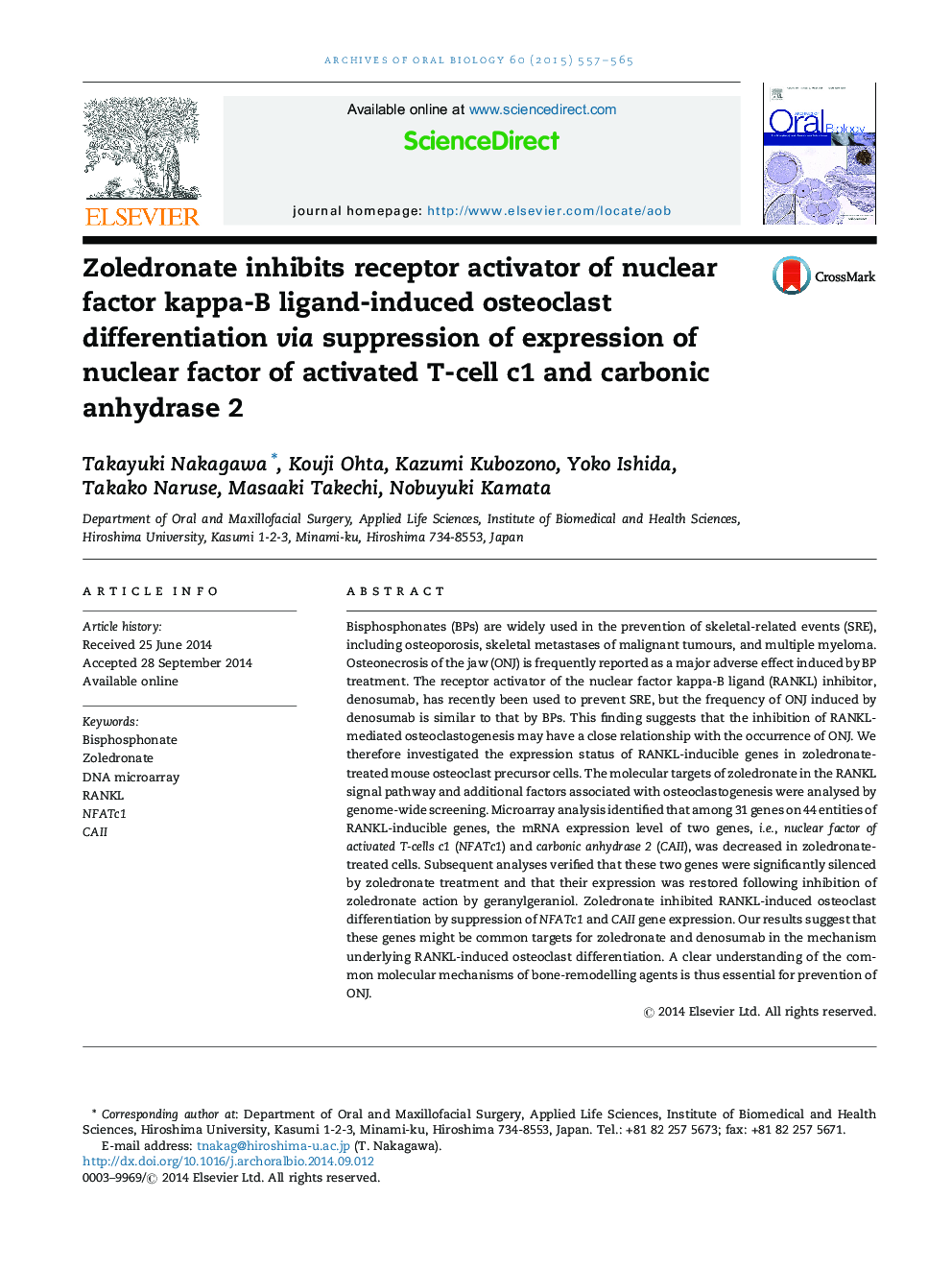| کد مقاله | کد نشریه | سال انتشار | مقاله انگلیسی | نسخه تمام متن |
|---|---|---|---|---|
| 6050961 | 1583301 | 2015 | 9 صفحه PDF | دانلود رایگان |
عنوان انگلیسی مقاله ISI
Zoledronate inhibits receptor activator of nuclear factor kappa-B ligand-induced osteoclast differentiation via suppression of expression of nuclear factor of activated T-cell c1 and carbonic anhydrase 2
دانلود مقاله + سفارش ترجمه
دانلود مقاله ISI انگلیسی
رایگان برای ایرانیان
کلمات کلیدی
موضوعات مرتبط
علوم پزشکی و سلامت
پزشکی و دندانپزشکی
دندانپزشکی، جراحی دهان و پزشکی
پیش نمایش صفحه اول مقاله

چکیده انگلیسی
Bisphosphonates (BPs) are widely used in the prevention of skeletal-related events (SRE), including osteoporosis, skeletal metastases of malignant tumours, and multiple myeloma. Osteonecrosis of the jaw (ONJ) is frequently reported as a major adverse effect induced by BP treatment. The receptor activator of the nuclear factor kappa-B ligand (RANKL) inhibitor, denosumab, has recently been used to prevent SRE, but the frequency of ONJ induced by denosumab is similar to that by BPs. This finding suggests that the inhibition of RANKL-mediated osteoclastogenesis may have a close relationship with the occurrence of ONJ. We therefore investigated the expression status of RANKL-inducible genes in zoledronate-treated mouse osteoclast precursor cells. The molecular targets of zoledronate in the RANKL signal pathway and additional factors associated with osteoclastogenesis were analysed by genome-wide screening. Microarray analysis identified that among 31 genes on 44 entities of RANKL-inducible genes, the mRNA expression level of two genes, i.e., nuclear factor of activated T-cells c1 (NFATc1) and carbonic anhydrase 2 (CAII), was decreased in zoledronate-treated cells. Subsequent analyses verified that these two genes were significantly silenced by zoledronate treatment and that their expression was restored following inhibition of zoledronate action by geranylgeraniol. Zoledronate inhibited RANKL-induced osteoclast differentiation by suppression of NFATc1 and CAII gene expression. Our results suggest that these genes might be common targets for zoledronate and denosumab in the mechanism underlying RANKL-induced osteoclast differentiation. A clear understanding of the common molecular mechanisms of bone-remodelling agents is thus essential for prevention of ONJ.
ناشر
Database: Elsevier - ScienceDirect (ساینس دایرکت)
Journal: Archives of Oral Biology - Volume 60, Issue 4, April 2015, Pages 557-565
Journal: Archives of Oral Biology - Volume 60, Issue 4, April 2015, Pages 557-565
نویسندگان
Takayuki Nakagawa, Kouji Ohta, Kazumi Kubozono, Yoko Ishida, Takako Naruse, Masaaki Takechi, Nobuyuki Kamata,